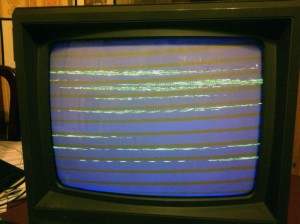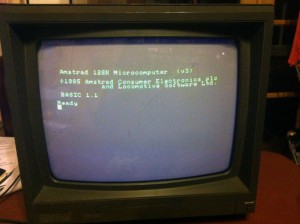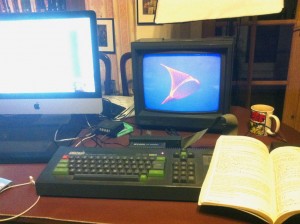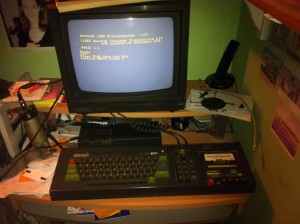It’s rare these days that I find myself with a little free time to work on getting my old Amstrad CPC 464 to work again. It has sat in my office for the last eight years, gathering dust and getting nowhere near being fixed once more. So it was a surprise when I had an hour to spare this evening – and I think I put it to good use.

The CPC was my first computer and, in computer terms, it remains my first love. I knew it didn’t work when I set it up on the library table today and gingerly turned it on to assess the damage. The screen was a mess of out-of-sync, warped text and the computer groaned rather than whined when it was turned on (Amstrads emit a high-pitched electronic whine when they are turned on so you can tell they haven’t crashed – when they crash, the whine stops).
This told me two things: power was still getting to the computer, and something – possibly more than one something – inside it was shorting out. I turned it off again, unplugged it from the power supply and set to work fixing it.
The first thing to do was open it up. With a CPC, all the computer components are inside the keyboard unit. The power comes through the monitor via a connector cable, so once that cable is disconnected, you know the unit is safe to work on. I disconnected the power cable, then took the screen information cable out as well, for good measure. Then I flipped the keyboard over and removed the six screws from the base, which gave me access to the inside of the computer.
I ignored the warning on the bottom of the keyboard to not open it. This machine was built in 1984, I think it’s out of warranty now.
Inside there were two connectors between the top and bottom halves of the case. I disconnected the one on the right because it would come away easily, but the multiple-wires connector on the left refused to budge, so I left it well alone. Inside the computer was a mass of dust and fluff. Suddenly it became very clear what was causing the short-outs.
I brushed as much of the dust and fluff out of the computer as I could, using a clean, dry paintbrush. Then I grabbed a vacuum cleaner, put a sock over the end of its nozzle (mostly to dull the power of the suction a little) and set to work cleaning out every part of the computer that I could reach.

When I was done, the computer looked nice and clean again. I reconnected the connection I had pulled out, closed the case and put the screws back in. Then I reconnected the power and monitor cables, plugged the computer in again and turned it on.
It worked. The sound is still wrong (there’s a crunchy noise when you turn the computer on and if there’s a high-pitched whine playing, I can’t hear it – but that could be because I’m somewhat deaf of course), so I’m going to have to open it up again and take a look at what’s going on there, but the welcome screen came up and I was able to type in a quick “graphics demonstration” from the CPC 464 manual, so all’s well and good in that regard.

All my old CPC cassettes are in the attic at my parents’ house, save for one. For some reason I still have a copy of Monty Python’s Flying Circus in my house, stored near the CPC for all these years. I think it’s because I used to enjoy reading the “manual” that came with that game in the large, full-priced version’s box (it’s not really a manual, it’s a set of sketches from the TV show plus some basic loading and playing instructions for the game).
One cassette isn’t the best method of testing whether the datacorder still works on this old machine (a failure to load could be because the datacorder is damaged, the cassette is damaged, or both) but it’s better than nothing.
I stuck the tape in the computer, typed Run””, pressed play and waited. The tape heads did not move. I pressed stop, tried fast forwarding the tape. It didn’t move at first, then started to move. I let it run on for a short time, then rewound it.
Again, the tape heads didn’t move at first, but then started to rewind. It took a little less time to start to rewind than it did to start to fast forward. Perhaps the tape heads are a little stuck, it has been a decade or so since they were used.
The tape rewound. I pressed “play”. The tape began to play through. That old, familiar digital whine began – duuuuh-diiiiiiir-duuuuuh,duuuuh-DIIIIIIIIIIIIIIIIIR-duh.

“Loading MONTY, block 1” appeared on the screen. It was working!
In total, the old Amstrad loaded the first three blocks of the game – enough to display the “copyright warning” loading screen – and then began the first block of code from the fastloader. Then it stopped.
I turned the computer off and then on again because the Control-Shift-Escape reset sequence didn’t work (I think the game disabled that for some reason – some games did that). This time there was no crunch noise when the computer turned off and no crunch noise when it turned on. Moreover, I definitely heard the high-pitched whine coming from the system this time! The longer I used to computer, the more alive it was becoming!
I rewound the tape – it began to rewind right away – and then tried loading the game again. It stopped at the same point. It seems there is a bit of a problem with the datacorder stopping and starting during program loading, which is causing some issues. This could be related to the problem with the playheads sticking, or it could be something else. I will have to investigate further.
All in all, this was an amazing resurrection of the old Amstrad. I’m really pleased with how quickly I got this computer up and running again. It’s a pleasure to see the old boy (with a codename like Arnold, I can’t help but think of it as an old man at this point) working once more. I’m looking forward to being able to play some of my old favourite games on it again, that’s for sure.
So, welcome back Arnold old friend. Now if I could only get you to recognise the disk drive…
